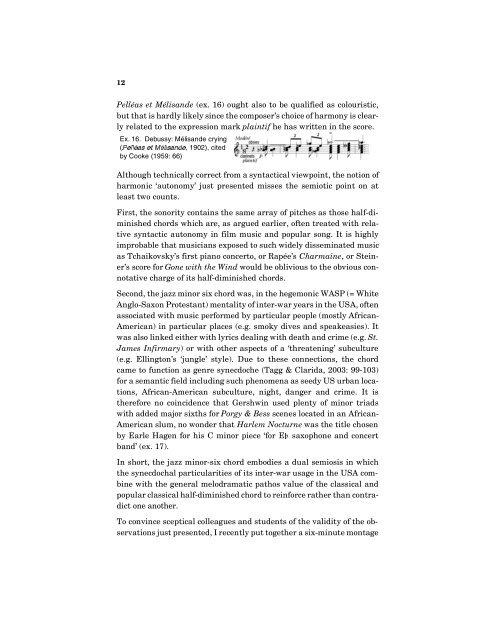You also want an ePaper? Increase the reach of your titles
YUMPU automatically turns print PDFs into web optimized ePapers that Google loves.
12<br />
Pelléas et Mélisande (ex. 16) ought also to be qualified as colouristic,<br />
but that is hardly likely since the composer’s choice of harmony is clearly<br />
related to the expression mark plaintif he has written in the score.<br />
Ex. 16. Debussy: Mélisande crying<br />
et Mélisande, 1902), cited<br />
(Pelléas<br />
by Cooke (1959: 66)<br />
Although technically correct from a syntactical viewpoint, the notion of<br />
harmonic ‘autonomy’ just presented misses the semiotic point on at<br />
least two counts.<br />
First, the sonority contains the same array of pitches as those half-diminished<br />
chords which are, as argued earlier, often treated with relative<br />
syntactic autonomy in film music and popular song. It is highly<br />
improbable that musicians exposed to such widely disseminated music<br />
as Tchaikovsky’s first piano concerto, or Rapée’s Charmaine, or Steiner’s<br />
score for Gone with the Wind would be oblivious to the obvious connotative<br />
charge of its half-diminished chords.<br />
Second, the jazz minor six chord was, in the hegemonic WASP (= White<br />
Anglo-Saxon Protestant) mentality of inter-war years in the USA, often<br />
associated with music performed by particular people (mostly African-<br />
American) in particular places (e.g. smoky dives and speakeasies). It<br />
was also linked either with lyrics dealing with death and crime (e.g. St.<br />
James Infirmary) or with other aspects of a ‘threatening’ subculture<br />
(e.g. Ellington’s ‘jungle’ style). Due to these connections, the chord<br />
came to function as genre synecdoche (<strong>Tagg</strong> & Clarida, 2003: 99-103)<br />
for a semantic field including such phenomena as seedy US urban locations,<br />
African-American subculture, night, danger and crime. It is<br />
therefore no coincidence that Gershwin used plenty of minor triads<br />
with added major sixths for Porgy & Bess scenes located in an African-<br />
American slum, no wonder that Harlem Nocturne was the title chosen<br />
by Earle Hagen for his C minor piece ‘for E$ saxophone and concert<br />
band’ (ex. 17).<br />
In short, the jazz minor-six chord embodies a dual semiosis in which<br />
the synecdochal particularities of its inter-war usage in the USA combine<br />
with the general melodramatic pathos value of the classical and<br />
popular classical half-diminished chord to reinforce rather than contradict<br />
one another.<br />
To convince sceptical colleagues and students of the validity of the observations<br />
just presented, I recently put together a six-minute montage














